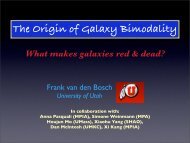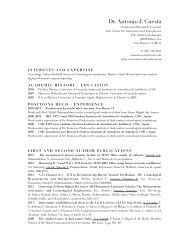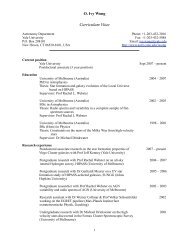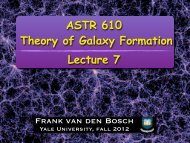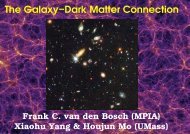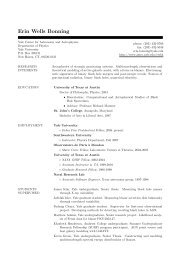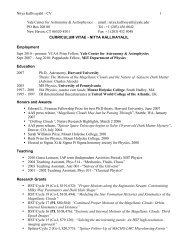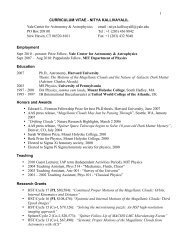ASTR 610 Theory of Galaxy Formation Lecture 16
ASTR 610 Theory of Galaxy Formation Lecture 16
ASTR 610 Theory of Galaxy Formation Lecture 16
You also want an ePaper? Increase the reach of your titles
YUMPU automatically turns print PDFs into web optimized ePapers that Google loves.
Dutton, vdBosch, Dekel & Courteau, 2007, ApJ, 654, 27<br />
Adiabatic Contraction<br />
Note: r M(r) is only an adiabatic invariant for spherical systems with circular orbits.<br />
In reality disk growth results in halo contraction that is slightly different. This can<br />
be parameterized by stating that r f =Γ ν r i , where Γ=r f /r i in the simplified AC<br />
case discussed above, and ν is a `free parameter’.<br />
standard AC<br />
Simulations suggest that ν 0.8<br />
ν =1<br />
ν =0<br />
ν V max , which is simply due<br />
to the self-gravity <strong>of</strong> the disk<br />
Model predictions for the ratio V 2.2 /V vir for<br />
disk galaxies embedded in NFW haloes. Results<br />
are shown as function <strong>of</strong> the halo concentration<br />
parameter, c. Here V 2.2 is the rotation velocity<br />
<strong>of</strong> the disk measured at 2.2 disk scale-lengths.<br />
Results are shown for different `forms’ <strong>of</strong><br />
adiabatic contraction (different values <strong>of</strong> ν ).<br />
For comparison, the green curve shows the<br />
ratio V max /V vir .<br />
<strong>ASTR</strong> <strong>610</strong>: <strong>Theory</strong> <strong>of</strong> <strong>Galaxy</strong> <strong>Formation</strong> © Frank van den Bosch: Yale 2012



